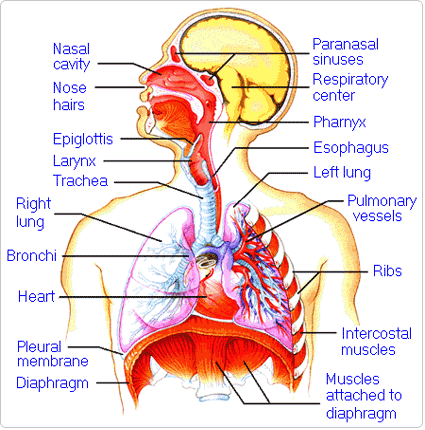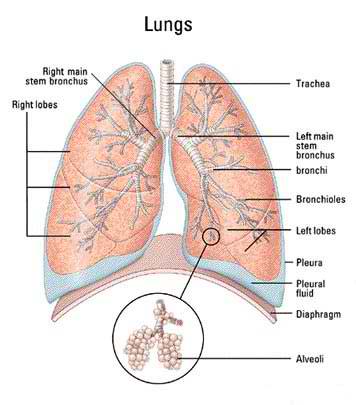Parts Of Respiratory System

NOSE
Anatomically, a nose is a protuberance in vertebrates that houses the nostrils, or nares, which admit and expel air for respiration in conjunction with the mouth. Behind the nose are the olfactory mucosa and the sinuses. Behind the nasal cavity, air next passes through the pharynx, shared with the digestive system, and then into the rest of the respiratory system. In humans, the nose is located centrally on the face; on most other mammals, it is on the upper tip of the snout.
PHARYNX
The human pharynx (plural: pharynges) is the part of the throat situated immediately posterior to (behind) the mouth and nasal cavity, and superior to the esophagus and larynx. The human pharynx is conventionally divided into three sections: the nasopharynx (epipharynx), the oropharynx (mesopharynx), and the laryngopharynx (hypopharynx). The pharynx is part of the digestive system and also the respiratory system; it is also important in vocalization.
LARYNX
The larynx (plural larynges), commonly called the voice box, is an organ in the neck of amphibians, reptiles (incl. birds) and mammals[citation needed] (including humans) involved in breathing, sound production, and protecting the trachea against food aspiration. It manipulates pitch and volume. The larynx houses the vocal folds (commonly but improperly termed the "vocal cords"), which are essential for phonation. The vocal folds are situated just below where the tract of the pharynx splits into the trachea and the esophagus.
tracheobronchial tree and lungs
The tracheobronchial tree is the structure from the trachea, bronchi, and bronchioles that forms the airways that supply air to the lungs. It is within the neck and the chest. The structure looks like a tree because the trachea splits into the right and left mainstem bronchi, which "branch" into more progressively smaller structures. The lining of the tracheobronchial tree consists of ciliated columnar epithelial cells. Injuries to the tracheobronchial tree are potentially fatal because they can interfere with breathing.
The tracheobronchial tree and the lung parenchyma comprise the lower respiratory tract.

VENTILATION
In respiratory physiology, ventilation (or ventilation rate) is the rate at which gas enters or leaves the lung. It is categorized under the following definitions:
Minute ventilation = tidal volume * respiratory rate the total volume of gas entering the lungs per minute.
Alveolar ventilation= (tidal volume - dead space) * respiratory rate the volume of gas per unit time that reaches the alveoli, the respiratory portions of the lungs where gas exchange occurs.
Dead space ventilation= dead space * respiratory rate is the volume of gas per unit time that does not reach these respiratory portions, but instead remains in the airways (trachea, bronchi, etc.).
LUNG RECOIL
Elastic recoil is the rebound of the lungs after having been stretched by inhalation, or rather, the ease with which the lung rebounds. With inhalation, the interpleural pressure (the pressure within the pleural cavity) of the lungs decreases. Relaxing the diaphragm during expiration allows the lungs to recoil and regain the interpleural pressure experienced previously at rest. Elastic recoil is inversely related to lung compliance.
This phenomenon occurs because of the elastic fibers in the connective tissue of the lungs and because of the surface tension of the film of fluid that lines the alveoli. As water molecules pull together, they also pull on the alveolar walls causing the alveoli to recoil and become smaller. But two factors prevent the lungs from collapsing: surfactant and the interpleural pressure. Surfactant is a surface-active lipoprotein complex formed by type II alveolar cells. The proteins and lipids that comprise surfactant have both a hydrophilic region and a hydrophobic region. By adsorbing to the air-water interface of alveoli with the hydrophilic head groups in the water and the hydrophobic tails facing towards the air, the main lipid component of surfactant, dipalmitoylphosphatidylcholine, reduces surface tension. It also means the rate of shrinking is more regular because of the stability of surface area caused by surfactant. Pleural pressure is the pressure in the pleural space. When this pressure is lower than the pressure of alveoli they tend to expand. This prevents the elastic fibers and outside pressure from crushing the lungs. It is a homeostatic mechanism.